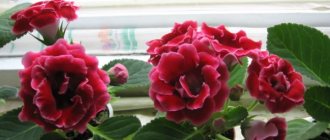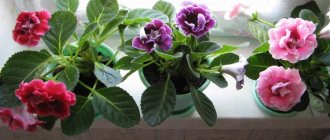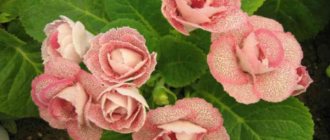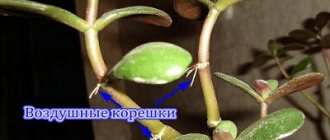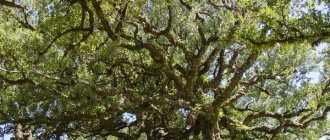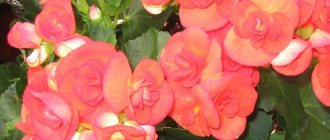Such an elegantly flowering plant as gloxinia is popular among flower growers. How to care for it and propagate it correctly so that the bush pleases with its amazing beauty? You should familiarize yourself with the rules of cultivation before you start growing this attractive crop.
Content
- Place for gloxinia
- Soil for gloxinia
- Planting a tuber
- Growing temperature
- Air humidity
- Watering gloxinia
- Feeding with fertilizers
- Gloxinia flowering
- The rest period of gloxinia
- Reproduction of Gloxinia
- Growing problems
- Gloxinia diseases
- Gloxinia pests
From a botanical point of view, Gloxinia Sinningia, the taxonomy of Gesneriaceae has changed, but among flower growers, their favorite flowers are still called Gloxinia, Gloxinia and Gloxinia. Therefore, in order not to create confusion, we will keep the outdated name, but remember that its name is Sinningia the Beautiful - a popular indoor plant, unpretentious, blooming profusely.
Place for gloxinia
Gloxinia is photophilous, but it is better not to place it in direct sun, especially in the flowering phase, the flowers quickly fade and the flowering duration is greatly reduced.
In the spring, when the sun is not yet too hot, it will feel good on a southern window, but with the onset of June-July (depending on the climate zone), the plant will need to be moved to eastern or even western windows, or shaded from direct sunlight.
I do this: until the gloxinia grows and lays buds, it is in the brightest place, and when the first flowers bloom, I put it in a less lit and cooler place.
Gloxinia is a long-day plant; for normal growth and development it needs 12-14 hours of lighting of at least 5000 lux. With insufficient lighting, especially during the period of early growth, the plants become very elongated, which subsequently negatively affects the number of buds laid. There will be few of them, or maybe none at all. After the tuber has rooted and the leaves appear, the lighting should be as bright as possible, then the plant stem will be shorter, a lot of buds will form and gloxinia will delight you with abundant flowering. The intensity of the color of future flowers also depends on the illumination; in bright light, the flowers have a rich color, and in low light the color is noticeably paler.
Gloxinia line 'Brocade'
Gloxinia line 'Brocade'
Gloxinia line 'Brocade'
Seedling care
Lupine as green manure - when to sow and when to bury
Seedlings definitely need quality care. This way she will grow strong and get sick less often. Caring for these plants is not difficult.
Seedlings need a lot of light to grow properly. If the spring is cloudy, the seedlings will lack sunlight and grow poorly. In this case, you need to install additional lighting and turn it on from lunch until the evening.
You cannot place containers with seedlings in a draft. When ventilating, the pots should be placed in a warm place. It is especially dangerous to leave plants in a draft after watering. Cold air and moisture can cause them to die.
Soil for gloxinia
You can use a mixture of leaf, peat soil and sand (1:1:0.5), but the composition may be different, the main condition is that the soil is loose and breathable. Acidity pH 5.5 - 6.5; gloxinia grows poorly on more acidic soils and for this reason pure, non-deoxidized peat is not suitable for it. Before planting the plant, I strongly recommend disinfecting the soil. Now I use the drug Maxim (1 ampoule per 2 liters of water).
Wide and shallow dishes are more suitable for growing gloxinia. For young tubers, pots with a diameter of 7-10 cm are suitable, and for larger and older ones 11-15 cm. Pots can be either plastic or clay.
Planting a tuber
In February - March, less often January (it all depends on the storage temperature) the tuber begins to germinate. If it was stored in a pot with old soil, you need to take it out and clean it of the remnants of last year’s roots and soil. Disinfect in a pink solution of potassium permanganate (30 min) or in any fungicide solution. For faster root formation, the tuber is soaked in a heteroauxin solution for 18-24 hours (making sure that the solution does not get into the recess of the tuber), but this is not necessary. The tuber is planted in the ground with the depression upward and sprinkled with soil no more than 1 cm. There must be drainage at the bottom of the pot (foam plastic, expanded clay, crushed stone chips, etc.). The higher the pot, the more drainage (up to 1/3).
During the period of tuber germination there are always the greatest losses and they are associated with waterlogging of the soil, as a result of which the tuber rots. Since the development of roots is preceded by the formation of the above-ground part, watering should be very careful along the edge of the pot or into the tray and only until the soil is lightly moistened. To avoid unwanted losses I do this:
I plant the tuber in moist soil level with it, place the pot in a bag and place it in a bright place without direct sunlight (22-25 degrees). I ventilate once a day for 10-15 minutes. After the first pair of leaves appear, I open the top of the bag and acclimate the young plant to room conditions for 3-4 days, then remove the bag completely. As the stem grows, I add soil and cover the tuber by 1-2 cm. While the plant is in the bag, there is no need to water it, the soil remains evenly moist and loose, increased air humidity and heat are maintained, the roots grow faster and there is almost no loss.
How to store gloxinia in winter
If the plant has successfully grown a tuber, then it is advisable not to leave it to overwinter in the soil for the first year.
You need to remove it from the pot, rinse thoroughly and dry. Then you need to place the “teenager” in a tight bag with wet peat or sawdust. Openings for ventilation and evaporation of condensate are required. Next, the bag is placed in a dark, cool place. About once a month you will need to inspect the contents in order to detect the appearance of rot or mold in time. But it is quite possible that your gloxinia will avoid such a fate.
Gently push the soil away from the plant stem. Didn't a well-developed tuber come into view? Then we leave the gloxinia to winter right in the pot. Again we wait for the complete death of the above-ground green mass. Cover the top with a tight bag with several holes. And put it away in the dark and cool.
If the place is too dry, then occasionally moisten the soil. But don't fill it up!
Both options are well tolerated by young gloxinias. Under normal storage conditions, this year's fresh shoots should appear as early as February. From that moment on, the pots are brought into the light. And they take care of them like full-fledged adult flowers.
Growing temperature
At the stage of tuber germination after a dormant period, it is necessary to maintain a temperature of about +25 degrees. After rooting and with the beginning of the growth of the vegetative mass, the temperature is reduced to +22 degrees during the day and +18 at night. Lowering the temperature is necessary so that in conditions of insufficient light (in February-March there is not enough light) the plants do not grow too rapidly and do not stretch out. The temperature does not need to be reduced, but in this case the plants need additional lighting.
During the growing season, the temperature should not fall below 18 degrees Celsius. Lower temperatures (from +15 - +20) slow down the growth and development of the plant. The optimal temperature for the growth and development of gloxinia ranges from +22 to +26 degrees.
During the active growing season, a short-term increase in temperature to +28 degrees is allowed, but at higher temperatures few buds are formed. If elevated temperatures persist for a long time, then gloxinia begins a period of stagnation, i.e. growth and development stop, and blooming flowers last no more than 3 days. Thus, we can conclude that high temperatures for gloxinia are even more destructive than excess lighting.
Gloxinia line 'Avanti'
Gloxinia line 'Avanti'
Gloxinia line 'Avanti'
Why doesn't gloxinia bloom at home?
The flowering of gloxinia is a fascinating sight. But sometimes flower growers are deprived of the opportunity to admire the wonderful bells because the plant refuses to bloom. There may be several reasons for this failure:
- Incorrect feeding
. The plant either does not receive enough necessary minerals or is fertilized too actively. In any case, gloxinia will react with yellowing leaves and poor flowering. - Lack of lighting, excessively high temperature
. The stem stretches, flowering is delayed or does not occur at all. - Incorrect landing
. When gloxinia, during care and propagation or transplantation, was planted in a too large pot, its tuber actively develops, and flowering is very poor. The optimal container size is up to 12 cm in diameter and 10 cm in height. - Diseases
. The flower begins to get sick, its energy is spent on fighting the disease and pests. Replanting and treating the flower with appropriate insecticides will help. - Sometimes already released buds curl and fall off
. This happens due to low air temperature in the home or a draft. - Old tuber
. It is more difficult to make an old plant bloom; it needs to be watered more often than young bushes.
Air humidity
Air humidity should be in the range of 70-80%, but gloxinia feels good even at a lower humidity of 50%, however, even lower humidity is undesirable, the plant develops poorly, growth slows down and deformation of the leaves occurs. The edges of the leaf blade are bent downwards.
To increase air humidity, you can place the plant on trays with wet expanded clay, moss, water, but gloxinia itself cannot be sprayed because brown, dry spots form. However, away from light and drafts, gloxinia tolerates water treatments very well. At night, you can take it into the bathroom, spray it or wash it with warm water and leave it there with the doors closed and the lights off until the water on the leaves has completely dried.
Watering gloxinia
For irrigation, you need to use soft water (melt, rain, filtered or partially boiled), chlorinated tap water must first be left for at least a day.
It is better to water from a tray or carefully along the edge of the pot, avoiding water getting on the leaves and in the center of the tuber (where the sprouts come from). in most cases, not from the roots, but from above, from the growing point, the tuber begins to rot. The water for irrigation should be warm, but if gloxinia is at a temperature of +18 degrees, this does not mean at all that you need to water it with water at a temperature of +25 degrees, nothing good will come of it. The water should be 2-3 degrees higher than the ambient air temperature. 20-30 minutes after watering, drain the remaining water from the tray.
Between waterings you need to dry out the soil. It is necessary to reduce the frequency of watering in rainy, cloudy and cold weather. At this time, the soil does not dry out for a long time, and the roots can rot from excess moisture.
Feeding with fertilizers
After planting the tuber, there is no need to feed gloxinia for the first 1.5 - 2 months. Fertilizers are applied an hour after the main watering, along the edges of the pot, making sure that the solution does not get on the leaves or at the growing point. It is advisable to do this in cloudy weather or in the evening, so that after feeding the plant is not in the sun. Fertilizing with complete mineral fertilizer alternates with organic fertilizers every two weeks, but the first fertilizing should be mineral.
Lack of iron in gloxinia (photo by Tideya)
You can feed once every 10 days, but then make the solution concentration weaker.
Before the appearance of buds, organic matter is alternated with nitrogen: (potassium nitrate, ammonium nitrate). With the appearance of buds, organic matter is alternated with phosphorus: superphosphate, potassium phosphate), if this is not done, dormant vegetative buds will awaken, which will lead to a suspension of the normal development of the plant.
- Nitrogen fertilizers cause increased vegetative growth; if they are in excess, flower buds are almost not formed. Excess nitrogen can also cause root rot. For this reason, nitrogen fertilizers are given only at the beginning of growth.
- Phosphorus fertilizers - enhance flowering, but their... excess causes premature aging of leaves and leads to chlorosis of the plant.
- Potassium fertilizers improve flowering. Excess leads to the formation of shortened peduncles, yellowing of the lower leaves, and deterioration of flower color.
- Microelements - affect the size of flowers, their color and the number of buds.
Organic fertilizers for tuberous flowers
Bird droppings
Manure is a very potent fertilizer and when using it, the concentration should be strictly observed. Pour 1 tablespoon of litter into 2 liters of water, close the lid and place in a warm and dark place. Over the next 3-4 days, stir with a stick until fermentation begins (bubbles appear on the surface). After the fermentation process is complete (about a week), the bubbles disappear, solid particles settle to the bottom of the jar, and the solution becomes lighter. It is now ready for use.
250 ml of concentrated solution is poured into 1 liter of water and mixed well; the plants are watered with this solution after preliminary moistening. (one hour after the main watering).
You can simply buy ready-made organic fertilizer.
Mineral fertilizer for tuberous flowers
for 10 liters of water take:
- 10 g simple superphosphate
- 10 g potassium chloride
- 4 g ammonium nitrate
- 5 g magnesium sulfate
- 0.1 g ferric chloride
- 0.07 g boric acid
- 0.004 g copper sulfate
- 0.05 g manganese sulfate
- 0.008 g of zinc sulfate.
If you can’t or are too lazy to look for everything separately, then just buy phosphorus-potassium mineral fertilizer and microelements.
I use Uniflor - flower, Uniflor-bud or Baby (dry, granulated for peppers and tomatoes) as phosphorus-potassium, Uniflor - growth, Uniflor - green leaf as nitrogen and Uniflor-micro as microelements.
After flowering, feed 2 times with potassium-phosphorus fertilizers with an interval of 14 days. This will help the tuber regain strength and survive the dormant period well.
Gloxinia hybrids F1
Gloxinia hybrids F1
Gloxinia hybrids F1
Gloxinia flowering
In a properly grown plant, buds are formed after the third or fourth pair of leaves. Their quantity depends primarily on the mass of the tuber and growing conditions (light, temperature, humidity).
Gloxinia can bloom again (for example, hybrids “Avanti” and “Brocade”) if the first flowering was early. In this case, the above-ground part (stem and leaves) is cut off, leaving a shoot about 2 cm high. Soon, gloxinia develops side shoots of the second generation (second growth) on which buds are laid, the plants bloom, but not as profusely as during primary flowering. Flowers are smaller in size.
Repeated flowering is not typical for all species and varieties of gloxinia; for example, the side shoots of the summer generation of the Kaiser Friedrich variety develop slowly, by the end of summer they manage to acquire leaves, but do not enter the budding and flowering phase.
Description of the plant
The second name for gloxinia is Sinningia. The plant is named after its discoverer, the doctor and botanist Benjamin Gloksin. Another scientist, Wilhelm Sinning, created several hybrid varieties, thereby diversifying the species.
The indoor flower Gloxinia belongs to the Gesneriev family. This family includes about 1,800 species, mostly native to the tropics and subtropics. All of them have one distinctive property - their flowering is extremely attractive. Plants love light and prefer cold wintering.
In appearance, gloxinia is similar to violet, with which they belong to the same family. The same rich colors, velvety leaves, a combination of several shades in one peduncle.
The flower's shoots are small if it receives enough light. The underground part is a tuber. The flowers are similar in shape to a bell, but each hybrid has its own unique shape.
During the winter, the above-ground part dies off, but the tuber continues to live in order to expel new shoots and set buds in the spring. The flower is large - from 5 to 7 cm in diameter, can be regular or double, grow singly or in an inflorescence. Sometimes you can find a specimen with up to 40 flowers.
The rest period of gloxinia
In the fall (September - October), when it becomes clear that the soil does not dry out for a long time after watering, watering is reduced, and after the leaves begin to turn yellow or dry out, they stop watering altogether. After the above-ground part of the plant completely dies off, the tuber goes into a dormant state, which lasts 3-4 months depending on the storage temperature.
Tubers are stored in several ways:
- The pot with the tuber is placed in a cool place with a temperature of +10 to +15 degrees. During the winter, the soil is slightly moistened several times so that the tubers do not dry out and become very wrinkled, especially if the tubers are small, they are stored worse because they dry out quickly. If the storage temperature is higher, then you need to moisten more often.
- 2 weeks after the above-ground mass has completely died, the tubers are dug up, cleaned of remaining roots and placed in damp sand and stored in a cool place. This method is convenient because at any time you can easily remove the tubers from the sand and inspect their condition.
This is how I store them: I dig up the tubers, place them in damp sawdust or sand and store them on the bottom or middle shelf of the refrigerator door.
Once a month I take out and inspect the tubers; if the sawdust dries out, I lightly moisten them and place the tubers there again. According to literary data, as well as based on data from Internet resources, storage temperatures below +8 degrees are detrimental for gloxinia. Based on my many years of experience, I cannot agree with this, the refrigerator is only +5, but I have never had any losses. The main condition is not to over-moisten the substrate in which the tubers are stored; it should only be slightly damp, and the sand can be completely dry.
Transfer
Transplantation is carried out at the end of winter. To do this, the underground part is taken out of the pot where it overwintered and cleaned of damaged scales. Next, the tuber is washed with warm water, possibly with the addition of potassium permanganate.
A tuber is planted in a prepared pot with drainage, which should be larger in diameter than the previous one, and temporarily covered with film. This is necessary to create a microclimate for bud germination. After green sprouts appear, the film is removed. Further care for gloxinia is carried out as usual, as for an adult plant.
A flowering plant cannot be replanted. The same goes for flowers with already formed buds. It's better to wait until next year.
Reproduction of Gloxinia
Gloxinias are easily propagated by seeds, leaf and stem cuttings, part of the leaf blade, peduncle and tuber division. Seed propagation is mainly for gloxinia species; you can get a lot of young plants at once and it is not advisable for varietal and hybrid ones; Character splitting may occur at the genetic level, which manifests itself in the external appearance of the plant. There is no guarantee that you will receive a plant with the original parental characteristics.
Sowing Gloxinia seeds
Sowing is carried out at the end of January - February (with mandatory additional lighting with fluorescent lamps) or in March. Seeds germinate in the light, they are sown superficially on a moist substrate (the composition is the same as for planting tubers), lightly pressed against it and covered with glass or film. The bowl with the crops is placed in a bright place. At a temperature of 24-26 degrees, germination begins 12-14 days from the moment of sowing; at lower temperatures it takes up to one month or even longer. Caring for crops comes down to maintaining temperature and humidity, preventing the soil from drying out. If there is a need to moisten the soil, this should be done from a pallet. There is no need to water from above because the seeds are small and can be easily washed off with water.
About a month after the appearance of the cotyledons, you can make the first pick, especially if the crops are thickened. They dive according to the 2*2 cm pattern into light soil. Another month, after the first pair of true leaves appear, the young plants are picked again or immediately planted in separate pots with a diameter of 6 cm (cactus). The temperature is maintained at least +20 degrees. Gloxinia tolerates picking well, and after it begins to grow intensively.
I do this: if the seeds are granular, I place them at a distance of 4*4 cm from each other in order to avoid picking in the cotyledon phase in the future. I put the bowl with the crops in a transparent cake box, and they remain there until 1-2 pairs of true leaves appear. After that, I plant them in separate pots and again put them in this mini greenhouse for 2 weeks for rooting and survival. In the future, I will accustom them to the open air of the room and, if necessary, transfer them to larger pots. My seedlings bloom 4-5 months after germination. Gloxinias grown from seeds may not have a dormant period in the first year, and will vegetate (continue to grow) all winter.
How to get gloxinia seeds
On the second day of flowering, after the flower blooms, take a soft brush and transfer the pollen to the stigma. The next day, to better guarantee pollination, repeat this procedure. If pollination has occurred, the perianth falls off after a few days, the ovary begins to grow, and along with it the receptacle noticeably thickens. The former flower, now an unripe dark green fruit, does not dry out for a long time. Seed ripening lasts 1.5 - 2 months and it is uneven, i.e. the seeds do not ripen at the same time in the box. After the fruit (box) opens, bring a piece of paper and, tapping the peduncle, shake out the seeds. After a couple of days, collect the seeds again. The seeds are very small, dust-like. Germination remains for 2-3 years. Germination is good. Normally, a plant should have no more than 3 seed capsules. If the plant is young or the tuber is of insufficient weight and size, limit yourself to one fruit and remove the excess ones.
Vegetative propagation of gloxinia
Vegetative propagation is the most common method; it is the simplest and most accessible. If rooting occurs in spring or in the first half of summer, then flowering can be seen from the resulting young plants in the same season.
Propagation of gloxinia by leaf cuttings
In the budding phase or during flowering, cut off the leaf of the lower tier of the rosette (young, upper leaves should not be taken). It is desirable that the petiole be short and thick; the size of the resulting tuber will depend on the diameter of the petiole. Next, you can proceed in a way convenient for you:
- Immerse the cutting in water to a depth of 1 - 1.5 cm and hold it until roots form (there is no need to change the water, just add if necessary), then plant it in the ground to a depth of 2-2.5 cm. For better survival of the cutting in the soil, it can be cover with a jar or bag.
- The cuttings are dipped in charcoal powder and planted in moist soil. Cover the top with a glass jar. At a temperature not lower than +22 degrees, rooting occurs within 2-3 weeks, then the jar can be removed. A little trick: if you only have one leaf, but you need to get two tubers, split the base of the petiole lengthwise to a length of 1 - 1.5 cm; after rooting, 2 smaller nodules will form.
Propagation of gloxinia by stem cuttings
If a gloxinia tuber has many side shoots, leave 1-2 and break out the rest. Stem cuttings are essentially finished plants, but without roots. They are rooted in the same way as leafy ones and they bloom in the same season.
Reproduction of gloxinia by leaf blade
- Cut off the large leaf at the base of the rosette. On the back of the leaf blade, make cuts across the protruding veins in the thickest places. Place the sheet on moist soil, press it to the soil in the places where the cuts are made and cover it with a bag or place it in a greenhouse. Roots will soon appear in the places where the cuts are made, and then nodules will form. It is important to maintain high humidity.
- The leaf plate is cut crosswise into 2-3 parts depending on the size of the leaf and each part is planted in soil or sand, covered with a jar or bag to maintain moisture. Root at a temperature not lower than +22 degrees. Optimal is about +25.
Reproduction of gloxinia by peduncle
It should be mentioned that not all gloxinia varieties can be propagated in this way. Some varieties take root well with peduncles, while others do not take root at all.
After the corolla has withered, the peduncle is broken out and placed 1 - 1.5 cm in water and care is taken that it does not touch the walls of the vessel. Do not change the water, add as it evaporates. After about a month, roots and a nodule form on it. After this, the peduncle is planted in moist soil to a depth of 1.5 - 2 cm. Care as for leaf cuttings.
Reproduction of gloxinia by tuber division
Large tubers that have more than two sprouts can be divided. The tuber is cut into pieces so that each of them contains at least one sprout. Sections of parts of the tuber are sprinkled with crushed charcoal, dried for 3-4 days in a dark place at room temperature and then planted in moist soil. Further care is similar to caring for a whole tuber after planting.
Seed method
But if you want to become like a breeder and develop your own unique hybrids, you can start breeding flowers from seeds. The generative method of reproduction is a rather long and labor-intensive process, but it has its advantages:
- The florist will be able to become the owner of a rare variety, since flower shops offer a wide selection of seed material.
- With this method of breeding, it is possible to feel like a breeder, having received your own hybrid
How to get gloxinia seeds at home
Original gloxinia seeds can only be obtained through artificial pollination and subsequent collection. The whole procedure looks schematically as follows:
- During flowering, pollen from the stigma of the female flower is transferred to the pistil of the male flower.
- After a few days, the corolla wilts, in place of which a seed pod is formed.
- Seed collection, depending on the variety, is carried out 1.5-2 months after signs of capsule opening appear.
You will see the details in the video:
Advice! Since gloxinia seeds are very small, it is worth transferring the cut box to a white container, where it is easier to see the brown seed.
Timing for sowing gloxinia seeds
Before planting gloxinia seeds, you should know: the germination rate of the seed depends on time.
When sowing in autumn or winter, the duration can be 9-10 days, while sowing in the spring-summer period will reduce the interval to 4-6 days.
Step-by-step recipe for growing gloxinia from seeds
Gloxinia from seeds at home is grown as follows:
- A shallow container for seedlings is prepared, which is filled with a layer of light substrate with a loose structure of peat and sand in equal parts.
- The seeds are distributed over the surface of the soil, after which they are moistened with a spray bottle.
- The container with the crops is covered with glass and placed in a well-lit place with a temperature within 22-23°C.
- When the shoots appear, the glass is removed.
- After the formation of 2 pairs of true leaves, the seedlings are planted in separate disposable cups, from where, after a while, the seedlings are planted in individual pots.
Possible failures when growing gloxinia
A tuber has not formed - this can happen when planting a very long stem cutting or if the cutting was planted very deeply and was watered abundantly.
The buds turn black and die - the reason is a lack of micronutrients and shortened daylight hours.
Redness of the leaves is a lack of phosphorus.
Yellowing of leaves - lack of nitrogen or overwatering.
Leaf discoloration is a magnesium deficiency.
Curling leaves - insufficient air humidity.
Spotting (non-infectious). There are yellow or brown spots of indefinite shape on the leaves - too bright lighting, drafts or watering with cold water.
Curling of flowers, slowing down of plant growth - temperature below +15 degrees.
Curling of the edges of the leaves and their arching, the formation of deformed flowers and shortened pedicels is an excess of moisture in the soil.
Rotting of petioles and buds - excessive soil acidity, excess nitrogen fertilizers, waterlogging of the soil.
The plant does not bloom - insufficient lighting, lack of nutrition, dry or cold air, improper maintenance during the dormant period, excess nitrogen fertilizers.
Possible errors when feeding and their elimination
With an abundance of nitrogenous fertilizers, leaf growth increases, but the number and size of flower buds decreases. Rotting of the tuber and cuttings may begin. Nitrogen deficiency makes gloxinia stems and leaves loose and susceptible to disease.
With a lack of phosphorus, flowering slows down. Excessive amounts of the element in the soil lead to rapid but short-term flowering.
If there is not enough potassium in the soil, the edges of the leaves turn yellow and look like they are burnt.
In case of excess fertilizer, the plant must:
- 1) replant into new soil with the addition of peat;
- 2) create conditions for optimal air temperature;
- 3) provide moderate watering.
The next feeding should be introduced no earlier than in a month.
Excess fertilizers cause more harm than their deficiency.
Gloxinia diseases
- Tuber rotting. Occurs when overwatering. At the initial stage, the disease is manifested by a decrease in leaf turgor; after watering, turgor is not restored. If the tuber is severely damaged, gloxinia droops completely. Leaf cuttings need to be cut and re-rooted. If the tuber has rotted away from the growing point, then the rotten parts are cut off to healthy tissue, disinfected in a strong solution of potassium permanganate or another fungicide, powdered with crushed coal and dried for 2-3 days, after which they are planted again in moist soil.
- Late blight. It is the most common disease of the Gesneriaceae family. It develops quickly and leads to the sudden death of gloxinia. It begins with slight wilting, then the growth of the stem stops and its color changes. After watering, the leaves wither even more, the base of the stem begins to rot, spreading to the petioles and leaves. An attempt to preserve the plant is unsuccessful; cut leaf cuttings do not take root and quickly turn black and rot. The plant must be destroyed along with the soil.
- Fusarium. The plant becomes infected through the soil. Leaves turn brown, curl and wilt. Dark stripes and cracks form on the stem. The defeat of a plant by fusarium is promoted by excessive watering and constant soil moisture.
More details fusarium
